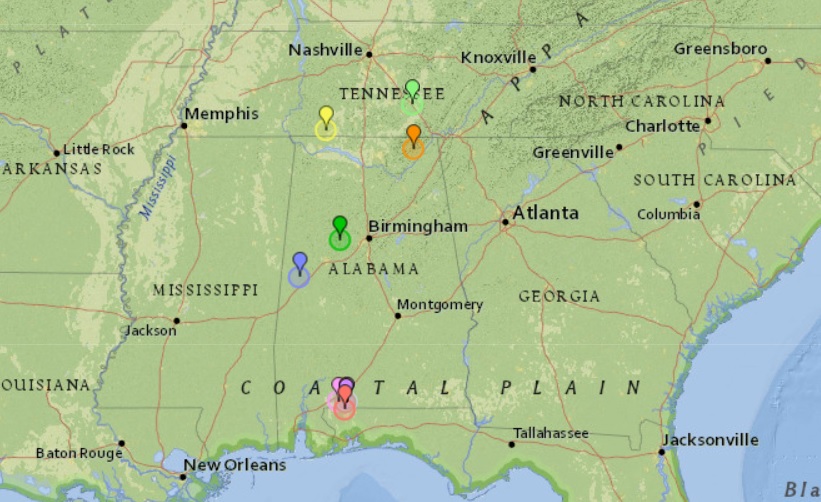By Bonita Wilborn
Just after noon on Tuesday, June 11, 2019, you might or might not have felt a slight trembling of the earth or heard a small rumbling sound, when a 2.4 magnitude earthquake reportedly took place in the Crow Mountain area of Jackson County.
According to Google’s Earthquake Tracker, in the past year, there has been a total of 18 mild to moderate earthquake recordings in the southeastern part of the United States, as follows:
• June 2018 – a 1.8 magnitude quake with a 9 km depth (approximately 5.5 miles), was recorded in Bridgeport, Alabama
• June 2018 – a 2.7 magnitude quake with an 8 km depth (approximately 5 miles), was recorded in Scottsboro, Alabama
• June 2018 – a 2.7 magnitude quake with a 10 km depth (approximately 6.25 miles), was recorded in Indian Springs, Georgia.
• June 2018 – a 1.8 magnitude quake with a 4 km depth (approximately 2.5 miles), was recorded in New Market, Alabama
• June 2018 – a 2.2 magnitude quake with a 13 km depth (approximately 8 miles), was recorded in Vernell, Georgia
• June 2018 – a 2.6 magnitude quake with a 10 km depth (approximately 6.25 miles), was recorded in LaFayette, Georgia
• July 2018 – a 2.2 magnitude quake with a 13 km depth (approximately 8 miles), was recorded in Trenton, Georgia
• July 2018 – a 2.5 magnitude quake with a 10 km depth (approximately 6.25 miles), was recorded in East Ridge, Tennessee
• August 2018 – a 1.9 magnitude quake with a 12 km depth (approximately 7.5 miles), was recorded in Dalton, Georgia
• August 2018 – a 2.1 magnitude quake with a 4 km depth (approximately 2.5 miles), was recorded in Hazel Green, Alabama
• September 2018 – a 2.6 magnitude quake with a 9 km depth (approximately 5.5 miles), was recorded in Chickamauga, Georgia
• September 2018 – a 1.9 magnitude quake with a 7 km depth (approximately 4.3 miles), was recorded in Dalton, Georgia
• October 2018 – a 2.3 magnitude quake with a 9 km depth (approximately 5.5 miles), was recorded in Altamont, Tennessee
• October 2018 – a 2.6 magnitude quake with a 9 km depth (approximately 5.5 miles), was recorded in Trion, Georgia
• December 2018 – a 4.4 magnitude quake with an 8 km depth (approximately 5 miles), was recorded in Decatur, Tennessee
• February 2019 – a 2.3 magnitude quake with a 9 km depth (approximately 5.5 miles), was recorded in Trenton, Georgia
• June 1, 2019 – a 2.6 magnitude quake with a 0 km depth (right on the earth’s surface), was recorded in Manchester, Tennessee
• June 11, 2019 – a 2.4 magnitude quake with a 12 km depth (approximately 7.5 miles), was recorded in Scottsboro, Alabama
It is somewhat disturbing to think about that much earthquake activity so close to us.
According to Wikipedia (the online encyclopedia), an earthquake (also known as a quake, tremor or temblor) is the shaking of the surface of the Earth, resulting from the sudden release of energy in the earth’s crust, that creates seismic waves (waves of energy) in the layers of the earth. Earthquakes can range in size from those that are so weak that they cannot be felt to those violent enough to toss people around and destroy whole cities. The seismic activity of an area, is the frequency, type, and size of earthquakes experienced over some time.
As you can see from the list above, in the past 12 months the frequency of earthquake activity in this area is quite surprising, but the size or magnitude of the quakes in the area are generally mild, with only one large enough to register as a 4.4 magnitude, in December 2018.
At the Earth’s surface, earthquakes manifest themselves by shaking and displacing or disrupting the ground. When the epicenter (or the point where an earthquake originates) of a large earthquake is located offshore, the seabed may be displaced sufficiently to cause a tsunami (large tidal wave). Earthquakes can also trigger landslides and occasionally volcanic activity.
In its most general sense, the word earthquake is used to describe any seismic event, whether natural or caused by humans that generate seismic waves. Earthquakes are caused mostly by the shifting of large rock masses, but also by other events such as volcanic activity, landslides, mine blasts, and nuclear tests.



